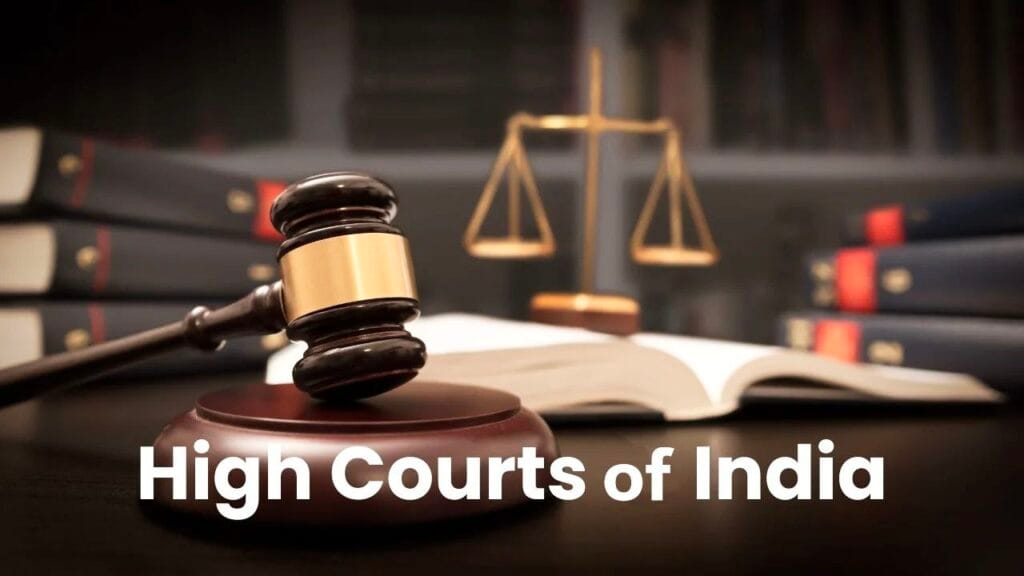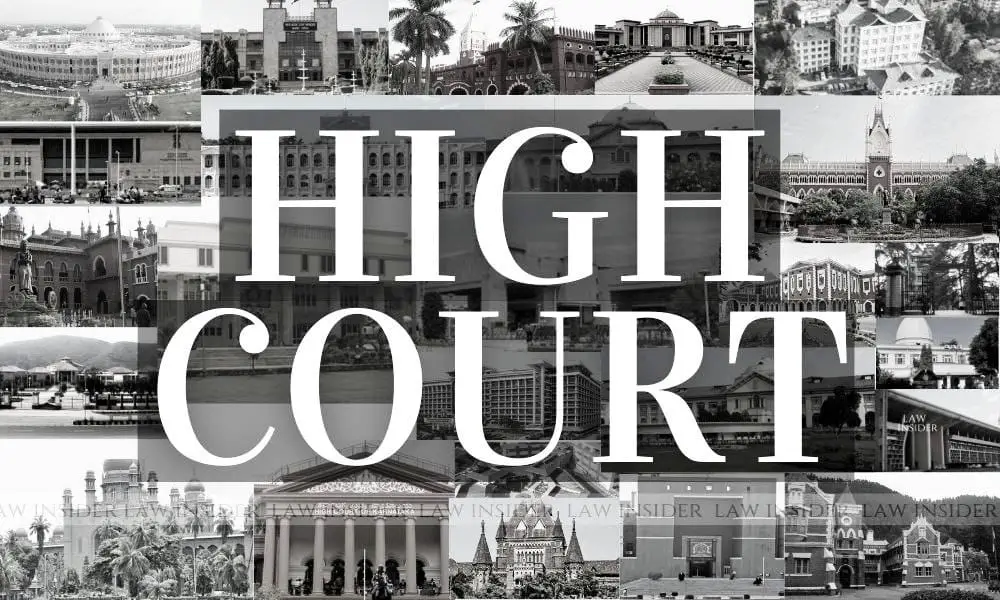Discuss The Composition And Functions of The High Court of India
The High Courts in India serve as the highest judicial authority at the state or union territory level, positioned below the Supreme Court of India. Each High Court exercises authority over a state, group of states, or union territories. The High Courts have the power to interpret the Constitution, review laws, protect fundamental rights, and oversee the functioning of lower courts. They act as both appellate and original courts, depending on the case.
Composition of the High Court of India :
The composition of the High Court is governed by Article 214 to Article 231 of the Indian Constitution. Each High Court consists of a Chief Justice and several other judges, whose number is determined by the President of India based on the case volume and workload of the High Court.
1. Chief Justice of the High Court:
- The Chief Justice is the head of the High Court and is responsible for its overall administrative functioning.
- The President of India appoints the Chief Justice after consultation with the Chief Justice of India and the Governor of the respective state.
2. Judges of the High Court:
- The number of judges varies from court to court based on the needs of the respective state or union territory.
- The judges of the High Court are appointed by the President of India in consultation with the Chief Justice of India, the Governor of the state, and sometimes the Chief Justice of the concerned High Court.
- The Collegium System, comprising senior judges of the Supreme Court and High Courts, plays an important role in the appointment of judges.
3. Qualification of Judges:
- A judge of the High Court must meet the following criteria:
- They must be a citizen of India.
- They must have held a judicial office in India for at least ten years, or
- They must have been an advocate in a High Court or in two or more such courts for at least ten years.
4. Tenure and Retirement:
- Judges of the High Court hold office until they attain the age of 62 years. The retirement age for High Court judges is lower than that of Supreme Court judges, who retire at 65.
- Judges may resign from their position by submitting their resignation to the President of India or may be removed by a process of impeachment for proven misbehavior or incapacity.
5. Transfer of Judges:
- Under Article 222 of the Constitution, the President, after consulting the Chief Justice of India, can transfer a judge from one High Court to another.

Functions of the High Court of India :
The High Courts play a dual role in the judicial system by functioning as courts of both original and appellate jurisdiction. Their powers can be classified into judicial, administrative, and supervisory functions.
1. Judicial Functions:
- Appellate Jurisdiction:
- The High Court hears appeals from decisions of lower courts (district courts, tribunals, etc.). These appeals may arise from civil, criminal, or constitutional cases.
- It hears civil appeals from decisions in lower courts on matters involving property, contracts, or personal disputes.
- It also hears criminal appeals, including cases of conviction or sentencing by lower courts.
- Original Jurisdiction:
- Under its original jurisdiction, the High Court hears cases directly without them being heard first by lower courts. These cases typically involve issues of:
- Fundamental rights violations under Article 226 of the Constitution.
- Matters involving the state government, local bodies, or public officials.
- Election disputes related to the election of state legislative members.
- Marriage, divorce, custody, and other family law matters.
- Under its original jurisdiction, the High Court hears cases directly without them being heard first by lower courts. These cases typically involve issues of:
- Writ Jurisdiction:
- The High Court has the power to issue writs (like habeas corpus, mandamus, prohibition, certiorari, and quo warranto) for the enforcement of fundamental rights or for any other legal right.
- Article 226 grants High Courts broader writ powers than the Supreme Court (Article 32), allowing them to address not only fundamental rights violations but also other legal matters.
- Civil and Criminal Jurisdiction:
- High Courts oversee a wide range of civil and criminal cases. They serve as the highest authority in deciding appeals and revisions from the decisions of lower courts.
- They can transfer civil or criminal cases from one court to another to ensure fair justice.
2. Constitutional Functions:
- Interpretation of the Constitution:
- The High Court plays an important role in interpreting constitutional provisions, especially in cases involving state laws and policies.
- It has the power of judicial review, which allows it to assess whether a law or executive action is consistent with the Constitution.
- Protection of Fundamental Rights:
- The High Court acts as the guardian of fundamental rights within its jurisdiction. Citizens can approach the High Court if they believe their rights have been violated.
3. Administrative Functions:
- Control over Subordinate Judiciary:
- The High Court has administrative control over all courts and tribunals within its jurisdiction. This includes the authority to appoint, transfer, and promote judges of lower courts (district and session courts).
- The High Court also ensures that lower courts function efficiently, follow judicial procedures, and deliver justice in a timely manner.
- Supervision and Inspection:
- The High Court conducts regular inspections of lower courts to ensure that they are functioning properly. It can issue guidelines for the efficient functioning of the judiciary.
- Appointment of Officers:
- The High Court has the authority to appoint various judicial officers and employees for the smooth functioning of the judicial system.
4. Supervisory Functions:
- Article 227 gives the High Court the power of supervision over all courts and tribunals within its jurisdiction. This includes the power to:
- Ensure that lower courts do not exceed their authority or jurisdiction.
- Set aside or modify decisions made by subordinate courts if they violate legal procedures.
- Supervisory Powers Over Tribunals:
- The High Court has jurisdiction over certain tribunals and can review their decisions. It ensures that tribunals, which deal with specialized issues (like taxation, labor disputes, etc.), function within the bounds of the law.
5. Election Petitions:
- The High Court handles disputes related to the election of members of the State Legislature or local bodies. Such cases may involve allegations of electoral malpractice or irregularities during the election process.
6. Miscellaneous Functions:
- The High Court also handles cases related to:
- Company law matters, including the winding up of companies.
- Admiralty law and maritime disputes (for High Courts located in coastal regions).
- Matters concerning public interest litigation (PIL), where citizens bring forward cases concerning public welfare or violations of constitutional rights.

High Courts with Original Jurisdiction :
While all High Courts in India primarily exercise appellate jurisdiction, some High Courts, especially those in Mumbai, Kolkata, Delhi, and Chennai, have significant original jurisdiction in civil cases. For example:
- The Bombay High Court and Calcutta High Court handle civil cases involving large sums of money directly under their original jurisdiction, unlike most High Courts which deal primarily with appeals from lower courts.
Conclusion:
The High Courts of India serve as vital institutions in the country’s judicial system, ensuring justice at the state level. With the power to interpret the Constitution, protect fundamental rights, and supervise the subordinate judiciary, they act as a bridge between the Supreme Court and lower courts. High Courts play a crucial role in maintaining the rule of law, delivering justice, and upholding the principles of democracy and fairness within their respective jurisdictions.
Share this content:


Leave a Reply